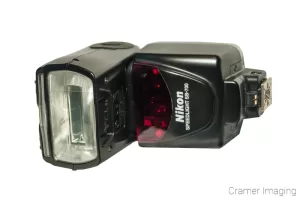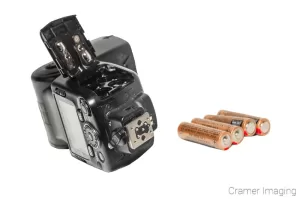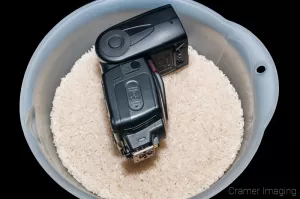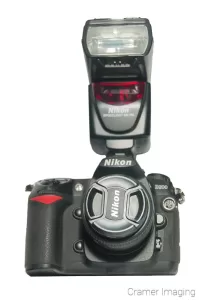
Ever drop a valuable piece of camera gear or other electronics in water? Then you know that sickening feeling of thinking your precious device is ruined forever. You feel like you just wasted money and you hope that your insurance is still good and will cover this. Recently, I had a similar experience but it didn’t end tragically. I saved my drowned camera gear. Here’s how I did it.

Well do I remember how sick I felt when I was attempting to photograph a bridge from out in the middle of a stream and my flash unit dropped off the camera into the drink. It was not secure on the flash cord and I knew that. This was an issue we knew about and worked around. However, there does come that painful moment of forgetfulness and focus on a different problem.
The soft plop of the flash breaking the surface is a sound I still remember. It ended my photo trip in a hurry that day. We fished it back out of the water and vented some feelings about our dismay and disappointment. Determined to not have just ruined an expensive piece of gear, we went home to find a solution.

Thankfully, there were solutions. We removed the batteries and did not attempt to power on the device since we knew that would be a risky move. If we would have turned it back on, we ran the risk of shorting out the electronics and permanently destroying my best flash. A little internet research into the subject later, and we had our answer to save my flash unit.

We learned that you can save many of your drowned electronics by removing the batteries and submerging them in a bowl of dry rice for at least 48 hours. This needs to be in a cool and dry location. Light is not a factor in this.

Bury your camera gear in dry rice and leave it in a cool and dry location where you won’t disturb it for at least two days. The rice, a trick also used to keep salt for clumping, will absorb the moisture from within the device. You can check on it after about 24 hours if you’re in a rush to have your device back.
This will save many and electronic device, camera gear included, from water damage. You must start this process as soon as possible in order to minimize initial damage of your important device. The longer you wait, the more the water can seep into other regions in the circuitry.
Hopefully, this rice drying method will save you some heartache and some money. I know that burying my flash in rice for two days saved us those problems. Good luck with your drowned camera gear and this method.
If you need any more tips on your camera gear, then you might check out this list of photography gear tips.
I cannot guarantee that you will not have voided out any warranty on the product by using this method of dealing with drowned camera gear instead of returning it to the manufacturer. If fact, I would feel much safer saying that you probably did just void your warranty. However, if your electronic device is already outside of the window of warranty, then you really have nothing to lose and much to gain by trying this.
If you still are under the warranty period, then my advice is to contact your manufacturer and see if the warranty covers this damage. If so, then this is a far better route to take. However, if the warranty won’t cover the damage, then you still have nothing to lose with the rice method.
This method should not be attempted with electronics where there is an opening directly into sensitive areas. Getting rice stuck in there may damage your equipment beyond repair, that is assuming that it wasn’t beyond repair already. This means that you don’t bury your camera bodies or high end lenses in rice.


Receive monthly updates in your inbox from us.

Join our email-only photo of the week club to get the full stories behind how we captured our favorite fine art landscape photos.
We respect your privacy
No More Results